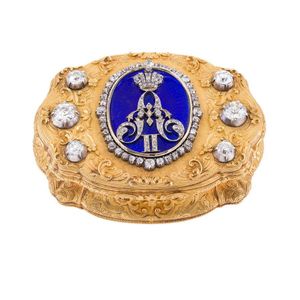Russian Imperial Diamond and Enamel Presentation Box
You must be a subscriber, and be logged in to view price and dealer details.
Subscribe Now to view actual auction price for this item
When you subscribe, you have the option of setting the currency in which to display prices to $Au, $US, $NZ or Stg.
- Embossed / Repousse - Embossing, also known as repousse, is the technique of decorating metal with raised designs, by pressing or beating out the design from the reverse side of the object.It is the opposite of chasing, where the decoration is applied from the front. An embossed or repoussed object may have chasing applied to finish off the design.
- Important - Important is a word used in the antique trade to indicate an object should be ranked above other similar objects, and is therefore more valuable.
The object could be considered important because it is by a famous designer or maker, has been shown at a major exhibition, is of exquisite workmanship, is rare or is a "one-off", was made for an important patron, and so on.
Even further up the pecking order are objects that are described in catalogue descriptions as highly important or extraordinarily important. - Circa - A Latin term meaning 'about', often used in the antique trade to give an approximate date for the piece, usually considered to be five years on either side of the circa year. Thus, circa 1900 means the piece was made about 1900, probably between 1895 and 1905. The expression is sometimes abbreviated to c.1900.
This item has been included into following indexes:
Visually similar items

A porcelain dessert plate from the Tsar Nicholas I service, by the Imperial Porcelain Factory, St. Petersburg, period of Nicholas I, with gilded and gadrooned scalloped rim, the central reserve painted with the badge of the Order of Saint Andrew on a white

An 18ct yellow gold 1897 sovereign brooch an English sovereign, 1897 with flower engraved frame. Total weight 11.35grams

An Art Deco style ruby and diamond ring, centring an approx. 0.30ct round brilliant cut diamond encircled by trapezoid cut rubies to surround of round brilliant cut diamonds in 18ct gold, size O.

A fancy yellow diamond cluster ring, the centrally set fancy yellow diamond totalling 1.01cts surrounded by a row of white diamonds totalling 0.68cts, and a further row of sapphires totalling 0.63cts set in 18ct yellow and white gold, ring size N.
